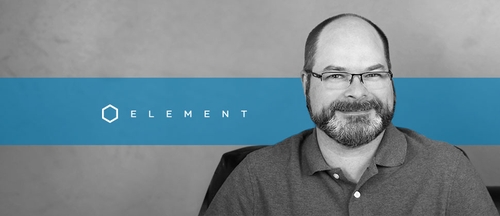2003: The year Ruben Studdard won season two of American Idol, AOL instant messenger was the No. 1 way to digitally communicate, MySpace was the just starting to take off … and Element opened its doors.
A lot has changed over the past 15 years. Our five-person operation that started in an office basement has grown to a staff of 37 employees, warranting the opening of our second location in Neenah in 2016. Today, we’re proud to celebrate this 15-year milestone and work with over 80 clients nationwide. However, as we’ve been growing and learning as a company, marketing has grown and evolved, too.
We asked a few of our teammates how marketing has changed in their area of specialty over the last 15 years … here’s what they had to say.
“It seems that digital marketing changes almost daily, so 15 years ago is more like 1,000 years ago,” says Element’s Director of Digital Marketing Derek Blaszak.
It’s true. From the explosion of social media to the evolution of Google, digital growth has been rapid. Consider Google’s development and how it’s shaped marketing. Launching in the late ’90s, the search engine quickly grew and expanded, launching Gmail in 2004, Google Maps in 2005, and Google Chrome in 2008. This platform changed the way people searched for information and how companies marketed and advertised.
The same holds true for social media, with Facebook launching in 2004, YouTube in 2005, Twitter in 2006, and Pinterest and Instagram in 2010, to name a few.
“Social media has evolved more than I would have expected, given its short lifespan,” shares Element’s Social Media Specialist Shelby Bake. “What was once a landscape of underground, disparate, scattered programs built on exclusivity and creativity has turned into the new norm to communicate and discover content, with robust advertising functionality built into each channel.”
Since 2003, online advertising has skyrocketed and continues to be a successful way to reach audiences and engage.
“The ability to micro-target our audiences based on specific behaviors and beliefs, and not just demographics, has really changed things in the last few years and is just a change in technology capability,” adds Blaszak. “While something like SEO has been around since the dawn of the search engines, authentic search intent-based optimization is probably the most dramatic shift.”
While content marketing has been around since 1732 when Benjamin Franklin began publishing the annual Poor Richard’s Almanac to promote his printing business, it hasn’t always been the most popular (or understood) marketing focus. More commonly, companies focused on features and benefits of their products using internal messaging to explain attributes.
In recent years, “content marketing” has turned into a buzz word, though only the savviest of marketers realize that it’s really just an evolution of “B2ME” marketing. Meaning, content marketing has evolved to take the reader or buyer into consideration and focus on the fact that, while they may be bucketed into B2C or B2B categories, at the end of the day, it’s still humans making decisions. Content marketing considers a buyer’s lifestyle, pain points, and, more importantly, answers questions and anticipated needs digitally along their path to purchase.
In the last 15 years, digital advancements such as social media, blogging, and other online tools have provided key methods to communicate, share, and amplify content. Think about how beneficial blogging can be to a content marketing and the fact it didn’t truly emerge until the 2004 presidential election when bloggers truly became influencers.
Developing a holistic and complete content marketing program takes time, but we enjoy creating strategic programs for our clients. Most recently, we helped Fresh-Lock® develop an e-book outlining how consumer trends are shifting the packaging industry. The educational piece uniquely shares ways to help their target audience create winning packaging solutions in a time of intense change.
When it comes to design, marketers are continually challenged to capture attention and create visual interest. This is done through changes in techniques and finding intriguing and graphical ways to tell a story.
“We live in an increasingly over-stimulating world, and there are no signs of that slowing down,” shares Element’s Art Director Aaron Graff. “Because of this, the job graphic design needs to do is more important than ever. Yet it’s still the same job it’s always had … deliver the message.”
“Now the message just needs to be delivered in a more succinct, direct, and efficient manner. We need to respect that people have less time and that attention spans are shorter. And, visually design needs to provide that category disruption that will make someone stop and notice. Design trends are an important thing to recognize and learn from but follow too closely and you’ll just disappear into the crowd,” Graff adds.
He also notes one trend that’s popped up over the years is the shift from skeuomorphism to flat design, Apple being the primary driver of this change.
This tactic is a way to create visual excitement, but as people start to grow accustomed to it, Graff notes that we’ll see skeuomorphism sneak back.
Designs like the ones below were recently developed for our clients Grass Run Farms and Marion Body Works, they blend bold, modern designs to command attention and visual interest.
Fifteen years ago, it was common for a business’ IT staff to develop a website, if it had one at all.
“Most people visiting websites would still be on dial-up, so websites and images needed to be small in order to load,” shares Element’s Director of Technology Kevin Hamilton.
Today, developing a modern website requires constant monitoring of trends and learning new skills. Websites are built to be more interactive, intuitive, and engaging, creating a natural pathway for a visitor. They’re also created in teams of interactive programmers, copywriters, and designers for a visually-exciting and easy-to-use experience.
“There’s a focus on mobile-first design over a desktop-only experience, now that mobile web usage has taken the lead. This shift in usage and viewport size also brought about responsive web design,” adds Graff. “Can you believe we used to design websites in static tables that never changed size?” he laughs.
Graff also comments on the explosion of new web fonts. “Fonts via @font-face, Typekit, and Google Fonts has allowed web design to look more unique, custom, and on brand.”
We recently helped our client TechDen™ launch a website blending advanced programming and design elements. This technology-based business needed a website to match its services, and the new site lives up to the standard.
Aside from digital design and engagement, the way marketers engage and work with the media has progressed, too.
“The modern state of the media has had a huge impact on the way we do PR,” shares Element’s Director of Public Relations Tara Brzozowski. “As newsrooms continue to shrink, it becomes more and more difficult to get stories and messages in front of reporters.
We are always looking for creative and fresh ways to present client stories and place great importance on developing one-to-one relationships with editors and reporters. “Social media offers not only a great way to amplify and share our clients’ stories, but it also is a great networking tool to connect and engage with the media,” she adds.
Evolving communication with the media pays off and helps us land feature stories and contributed articles for our clients, like Aptar’s recent feature in Brand Packaging.
As companies continue to assess their marketing spend against successes, there is a greater emphasis placed on ROI.
“As PR professionals, we need to find ways to tie our efforts back to the bigger marketing strategy and KPIs the same way paid or digital media would,” adds Brzozowski. “This goes beyond impressions and advertising value equivalent (AVE) but looking at how PR can drive leads and potential customers further down the sales funnel.”
Celebrating Change and Growth for Marketing Wins
We’re humbled to have had the opportunity to grow and thrive over the last 15 years – but more importantly, develop as marketing has grown. As marketers, we know marketing will continue to change as consumers do. We’re looking forward to staying on top of marketing changes, sharing tips through our weekly #PRBrief, and celebrating the future.
We’ve done a lot this week to applaud our growth. Check out our Facebook page to see the fun activities we surprised our employees with to show appreciation for all the hard work and accomplishments. We are incredibly thankful for our clients and business partners that continue to believe and trust Element. Cheers to 15 years, everyone!

















